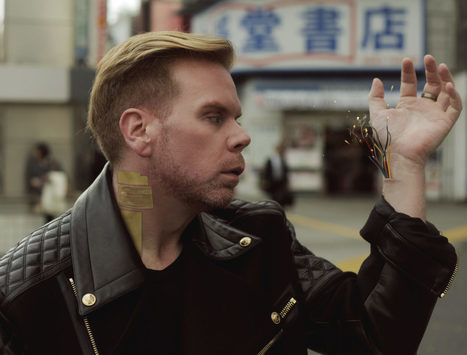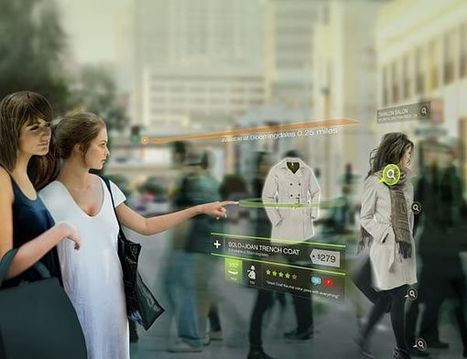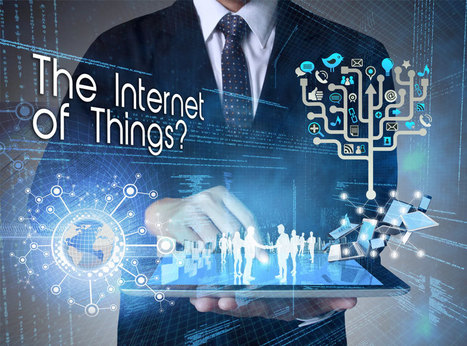 Your new post is loading...
 Your new post is loading...
Prima di iniziare, c’è un elemento da chiarire subito, perché rappresenta un errore che risiede nelle nostre teste: come immaginiamo un cyborg?
Di base, si immaginano i cyborg come robot umanoidi dotati di un’intelligenza artificiale super avanzata. I cyborg che popolano la nostra fantasia hanno come unico scopo nella loro infinita vita quello di sterminare la razza umana, per questioni di dominio o chissà cos’altro.
Il motivo di ciò è da imputare a film, libri e fumetti fantascientifici, spesso improntati sulla paura. Questo forse per avere più attenzione da parte dello spettatore, perché un sentimento negativo, come la paura, riesce a tenerti incollato allo schermo (o al libro, o al fumetto), al contrario –ad esempio- di un sentimento positivo, come la curiosità del futuro. Così, non ci rendiamo conto che, invece, siamo già circondati dai veri cyborg da anni.
Il transumanesimo
Facciamo un ulteriore passo in avanti e definiamo il transumanesimo: è una corrente di pensiero che propone di utilizzare in modo invasivo tutte le forme di tecnologie immaginabili (e ancora inimmaginabili) per superare i limiti umani, quali:
– invecchiamento, ovvero il deterioramento del corpo umano, che ha come conseguenza la morte;
– malattie
-mutazioni genetiche
– capacità mentali e fisiche.
Il transumanesimo è attualmente un futuro molto lontano e parecchio esasperato, ma può esserci da punto di partenza per parlare dei cyborg.
L’anno scorso, a ottobre 2016, in Svizzera, si sono tenute le Cybathlon, il primo evento sportivo orientato completamente verso atleti che usano dispositivi high-tech (protesi, esoscheletri e altri dispositivi robotici ed assistivi).
Di differenziano dalle Paralimpiadi perché non si tratta di sport “comuni” praticati da persone diversamente abili. Si tratta di discipline totalmente nuove, che spesso possono fare esclusivamente i cyborg.
Ad esempio c’è la Corsa Brain Computer Interface, dove persone che utilizzano la BCI controllano degli avatar che devono correre lungo un percorso.
Lo scopo del Cybathlon è sia di invogliare a investire sulla Ricerca in questo ambito e sia di cambiare la percezione che si ha delle persone che usano queste tecnologie, cercando di farle percepire come “normali”.
Quindi, attualmente un cyborg è una persona che usa la tecnologia per ristabilire una funzionalità persa o parzialmente danneggiata.
C’è, però, la nuova generazione di cyborg, ovvero i cyborg ricreazionali, che vogliono diventare cyborg (ad esempio aspirando ad una vista o udito perfetti) solo perché possono e vogliono farlo.
I cyborg ricreativi
L’uomo nella foto qui sopra è il professor Steve Mann, conosciuto ai più come il primo cyborg al mondo (anche se, da quanto abbiamo detto prima, possiamo intuire che questa definizione non è proprio corretta).
Se non possiamo essere sicuri di definirlo “il primo cyborg al mondo”, possiamo però essere sicuri che è stato il primo ad avere una foto sul passaporto (nel 1995) in cui appare come un cyborg.
Steve Mann non è un novellino: ha iniziato a lavorare su dispositivi indossabili già quando frequentava il liceo, negli anni ’80. All’epoca già lavorava un “occhio digitale”.
L’IEEE, ovvero l’Institute of Electricaland Electronics Engineering ha definito Steve Mann come il padre della realtà aumentata e dei dispositivi elettronici indossabili.
Avete presente l’HDRI (High Dynamic Range Imaging)? l’ha inventata lui.
L' Eyetap digital eye glass. E’ un dispositivo in grado di catturare tre immagini simultaneamente a diverse esposizioni. Le immagini vengono combinate insieme in real time per produrre una visione del mondo che ha una ricchezza di dettagli irraggiungibili per l’occhio umano. Quindi, con questi occhiali, Steve Mann vede dettagli che normalmente nessuno vede.
Il passo successivo che sta portando avanti è di inserire questo sistema (con una telecamera) dentro un occhio prostetico.
E, a proposito di telecamere, qui si aprirebbe anche tutto il discorso delle registrazioni effettuate con questi dispostivi. Mann (e molti altri) dicono che queste registrazioni si possono paragonare alla memoria umana, mentre molti altri dicono che il paragone non sussiste.
L’uomo con più sensori addosso
Pensate sia troppo? Spingiamoci un po’ oltre: parliamo di Chris Dancy, considerato “l’uomo più connesso al mondo”.
Ha centinaia di sensori addosso, che acquisiscono dati in tempo reale sulle più svariate informazioni. Lui afferma di utilizzare questi dati al solo scopo di migliorare le sue abitudini. Pensate che ha perso anche 45kg.
E’ convinto che questo sia il futuro; afferma che bisogna ancora capire come utilizzare al meglio queste informazioni, ma è convinto che in un futuro non troppo lontano, le persone misureranno più dati possibili riguardo il loro stato di salute, o lo stato dell’ambiente in cui vivono.
Quindi, non solo i cyborg sono già tra noi, ma a quanto pare sarà sempre più possibile aumentare le proprie capacità fisiche e mentali, proprio come vuole il transumanesimo.
La convergenza di cloud, mobile, big data, social e di sensori dall'altra, sta generando enormi nuove opportunità per le aziende di offrire ai propri clienti e dipendenti servizi e modalità d'interazione fino a ieri impensabili.
La realtà aumentata è una forma di smart tagging e dunque un volano importante per un ‘Internet of Thing che sta diventando una Internet of… Everything. Ma è anche un codice informatore importante per l’analisi dei Big Data. La movimentazione del mercato 2013 parla di 670 milioni di dollari nel 2013.(Fonte: Abi Research).
|
As I am certain that the huge waves of technological change transform the medical professional palette; based on the current and prospective trends in digital health technologies I envisioned what potential new professions could appear in our lives. Don’t miss the first part of the list!
If you have an idea about another new job of the future, please let me know and I will keep on improving the list.
1) No one knows what disease are you suffering from? Ask a healthcare navigator!
Do you remember what the biggest challenge for Hugh Laurie as Doctor House was in the famous series for solving medical mysteries? Yes, you are right, to actually talk to patients and be in close vicinity to people. He would be very pleased to know that in the future, the work of a specialized diagnostician would not involve direct contact with patients if he did not want to.
He could work in a team with actual caregivers, who can provide patients with the adequate amount of attention and care, and with AI algorithms, which would scan through billions of documents within minutes to find the one hidden solution for a very rare medical problem. His job would be to piece together the relevant information and forward it to caregivers with the necessary therapeutic recommendations.
2) Healing will be joy and fun with gamification specialists
Somewhere in the 2040s: Peter and his family was celebrating his wife’s 50th birthday, when he suddenly felt a twitch in his head and fell unconscious. The ambulance came within minutes, and the medical drones helped transport him very quickly to get adequate care. It turned out he had a stroke and his healing process will take several months. After telling him the diagnosis, his physician consulted a gamification specialist about the next steps.
He wanted him to design a treatment with the help of VR/AR, in which Peter could learn to use his left hand again through a strategic computer game. By playing it, he has to climb through walls and collect coins to be able to reach the innermost chamber of a medieval castle. In the next days, the gamification specialist worked on streamlining an existing game to Peter’s needs. The game got ready for the day, when the physician told Peter to start the rehabilitation process.
There are millions of ways, in which gamification could make healthcare more fun and help people at the same time. It already started. Just think about Plant Nanny, the app which helps you drink the right amount of water a day by allowing you to bring up a little plant! Or remember all the fitness wearable challenges out there. Such as the ones offered by Fitbit, which urge you to stay fit by competing with your peers. But the future holds more complex issues in gamification. Coupled with the possibilities in virtual reality or augmented reality, gamification specialists could plan whole personalized games to follow their treatment plan – such as the above.
3) Augmented/virtual reality operation planners for the success of every surgical intervention
Before complex operations, such as implantations or tumor removals, surgeons have to prepare extensively. 3D-printed organs or AR/VR will be of huge assistance in the future. A promising start-up, Medsights Tech already developed a software to test the feasibility of using augmented reality to create accurate 3-dimensional reconstructions of tumours. The complex image reconstructing technology basically empowers surgeons with x-ray views – without any radiation exposure, in real time.
Within 20-30 years, AR/VR operation planners will help surgeons in the preparation for very complex surgical interventions. While the medical professional explains what kind of operation will unfold, the planner visualizes the organs and the whole process through AR/VR. Sounds like a wonderful job for medical geeks, doesn’t it?
4) Reducing suffering and alleviating pain through professionally designed VR therapies
Brennan Spiegel and his team at the Cedars-Sinai hospital in Los Angeles introduced VR worlds to their patients to help them release stress and reduce pain. With the special goggles, they could escape the four walls of the hospital. They are able to visit amazing landscapes in Iceland, participate in the work of an art studio or swim together with whales in the deep blue ocean. A similar project called Farmoo helps teen cancer patients get distracted during chemotherapy treatments.
In the future, VR therapy designers could use the immense potential in VR for alleviating pain and reducing suffering. Especially for patients, who have to combat mental illnesses such as PTSD, phobias or other psychological disorders. VR therapy designers will be experts in psychology as well as in VR design. Their aim will be to create the adequate, personalized virtual environments and programs for patients to get through the worst periods of their lives with the most help possible.
5) With the rise of nanosolutions, nanomedical engineers will be in huge demand
Somewhere in the 2030s: Lora had been feeling dizzy for a while. She could not explain her fever at nights, why she had been losing weight or why she was sweating a lot at night. Her smartphone got an appointment at her GP’s office and after a couple of exams it turned out she had lymphoma. She was shocked, but her doctor reassured her that in such an early stage the disease could be treated.
Afterwards, the physician consulted with a nanomedicine engineer who offered a great solution. He worked out a personalized therapy consisting of chemotherapy molecules applied to nanocages. Lora had to go to her doctor for an injection treatment, and these nanocages were injected into her body. Then, the tiny chemotherapy molecules exerted their effect only if they “bumped” into cancerous cells; and the lymphoma was cured way more efficiently and with much less pain and inconvenience.
The rise of nanotechnology is just around the corner, so highly targeted oncology treatments and medical professionals, who are able to substantially design and plan such personalized therapies, will be in demand very soon.
6) Do you have trouble with sending data from your home sensors to your smartphone? Ask an internet of healthy things connector!
Somewhere in the 2040s: similarly to every other family in the suburban Quebec neighborhood, Eva and her husband had a network of smart sensors at home. For example, they used CubeSensors – small, very simply designed cubes all over their house. The smart cubicle measured air quality, temperature, humidity, noise, light, air pressure. Based on their personal information it adjusted the relevant factors for optimizing their well-being at home. Similarly, Eva and her husband had a swarm of wearables for sleep tracking, fitness activities and measuring vital health parameters. So when she suddenly felt ill, she wanted to send all the supporting data to the AI medical assistant to help the smart algorithm analyse the data in minutes and figure out the diagnosis without bothering an actual doctor.
But she was simply unable to put the data together due to compatibility issues. So she called an internet of healthy things connector, a technologist with a sense of medicine. He was able to fix the compatibility problem. Moreover, he also helped in designing the appropriate digital health solutions between smart sensors used at home and everyday healthcare. In the future, a swarm of such technicians will populate the field of digital healthcare.
7) Do you have trouble in getting from A to B in the healthcare jungle? Hire a patient assistant!
Somewhere in the 2030s: Emily was born as a healthy, curious little baby girl. The problems started when she went to primary school. Her mother realized that Emily acted hyperactively, had a very hard time focusing on tasks, had a supersensitive self and suffered a lot from her environment. But what to do in this situation? She didn’t know any medical professional, she had no experience in the field of psychology or psychiatry. And as she was searching in her laptop about potential medical solutions or therapies to ask about, a Google ad popped up on her screen. Hire a patient assistant!
She called the indicated number and a friendly female voice replied. They arranged a meeting, talked about the situation and the patient assistant crafted various possible patient routes to follow. The nice lady had extensive medical background, a thorough knowledge about the healthcare system – together with how to solve insurance troubles -, as well as an extensive network. Emily’s mother was relieved that her little girl got into the right hands. I am wondering why there is no such service today. Where are the patient assistants? I hope they will appear as soon as possible in the healthcare system.
8) End-of-life therapists will prepare patients for death
In his thought-provoking critique of society, God Bless You, Mr. Rosewater, Kurt Vonnegut explains that in the future, as all serious diseases had been conquered, death became voluntary and the government, to encourage volunteers for death, set up a purple-roofed Ethical Suicide Parlor at every major intersection. While it is obviously a satire, it taps into the very difficult question how we will handle death in the future. And how our attitude towards death will change gradually.
People will live a longer, healthier life and although it is currently unimaginable, it might become a reality that they will actually be able to decide about their own death. As it is such a huge psychological burden, which we are not able to process, we will need therapists specialized in death. These psychologists could help prepare for death; help those who decide when they want to end their life and also those who decide they choose to live on synthetically by e.g. uploading their consciousness to a computer.
9) Does your cyborg neighbor complain constantly about his life? Send him to a cyborg therapist!
Neil Harbisson lives with a specialized electronic eye, rendering perceived colours as sounds on the musical scale. Dr. Kevin Warwick installed a microchip in his arm, which lets him operate heaters, computers and lights remotely. Jesse Sullivan became a cyborg when he got equipped with a bionic limb, which was connected through nerve-muscle grafting. Cyborgs are already living with us, and there is going to be more and more people with implanted sensors, prosthetics, neuroprosthetics or bioprinted organs.
I know that it is already mind-blowing for some people to read about cyborgs living among us. Then imagine how difficult it is going to be to process the whole phenomenon in the future. That’s the reason why we will need professionals: cyborg therapists who will offer help for people living as cyborgs to integrate into society successfully.
10) Health data analysts wanted for making sense of big data!
With the evolution of digital capacity, more and more data is produced and stored in the digital space. The amount of available digital data is growing by a mind-blowing speed, doubling every two year. In 2013, it encompassed 4.4 zettabytes, however by 2020 the digital universe will reach 44 zettabytes, or 44 trillion gigabytes (!). Besides, with the availability of cheap genome sequencing, gazillion of wearables, healthcare trackers and home sensors, as well as other methods for obtaining data about our health, huge amounts of medical data will be created.
In the future, health data analysts will be in huge demand to constantly analyse big health data, bring them to the same platform, convert them and interpret them adequately. Even dealing with data when the patient brings their sensors’ measurements to the GP’s practice will involve the work of data analysists.
11) People with paralysis will get help from brain-computer interface designers!
Somewhere in the 2050s: Edward had a serious car accident, when his driverless car could not brake in time in the ice storm. It was one of the biggest accidents in years in the UK. He survived it, but he suffered a spinal cord injury and could not move his legs or hands anymore. However, with the help of brain-computer interfaces (BCIs) connected to various devices, he is able to carry out specific actions. BCIs made him able to still have some control over his life and his environment after he had lost his ability to move around.
BCIs acquire brain signals, analyse them, and translate them into commands that are relayed to output devices that carry out desired actions. Their main goal is to replace or restore useful function to people disabled by neuromuscular disorders such as amyotrophic lateral sclerosis, cerebral palsy, stroke, or spinal cord injury. In the future, the design of such delicate interfaces will require specialists passionately working on BCIs during their whole workday.
Did I blow your mind with my predictions? I hope you have also seen the first part of our article series, where I described the future tasks of organ designers, robot companion engineers or telesurgeons. Are you skeptical about the current healthcare trends and where they are leading us? Don’t be. Rather prepare for the huge changes in medical health by subscribing to my newsletter and following the trends here.
Il mercato associato all’Internet delle cose (sensori, servizi, piattaforme e analytics) crescerà dai 1.900 miliardi di dollari del 2013 ai 4.600 miliardi del 2018, sostiene Idc, con un Cagr del 19%. A fine 2014, si stima un valore del mercato vicino ai 2.300 miliardi di dollari, dei quali il 27% circa derivanti dall’ambito consumer, il 19% dal settore pubblico e il resto dall’insieme dei comparti industriali.
|



 Your new post is loading...
Your new post is loading...











